AUDI A5 COUPE 2016 Owners Manual
Manufacturer: AUDI, Model Year: 2016, Model line: A5 COUPE, Model: AUDI A5 COUPE 2016Pages: 264, PDF Size: 66.92 MB
Page 131 of 264
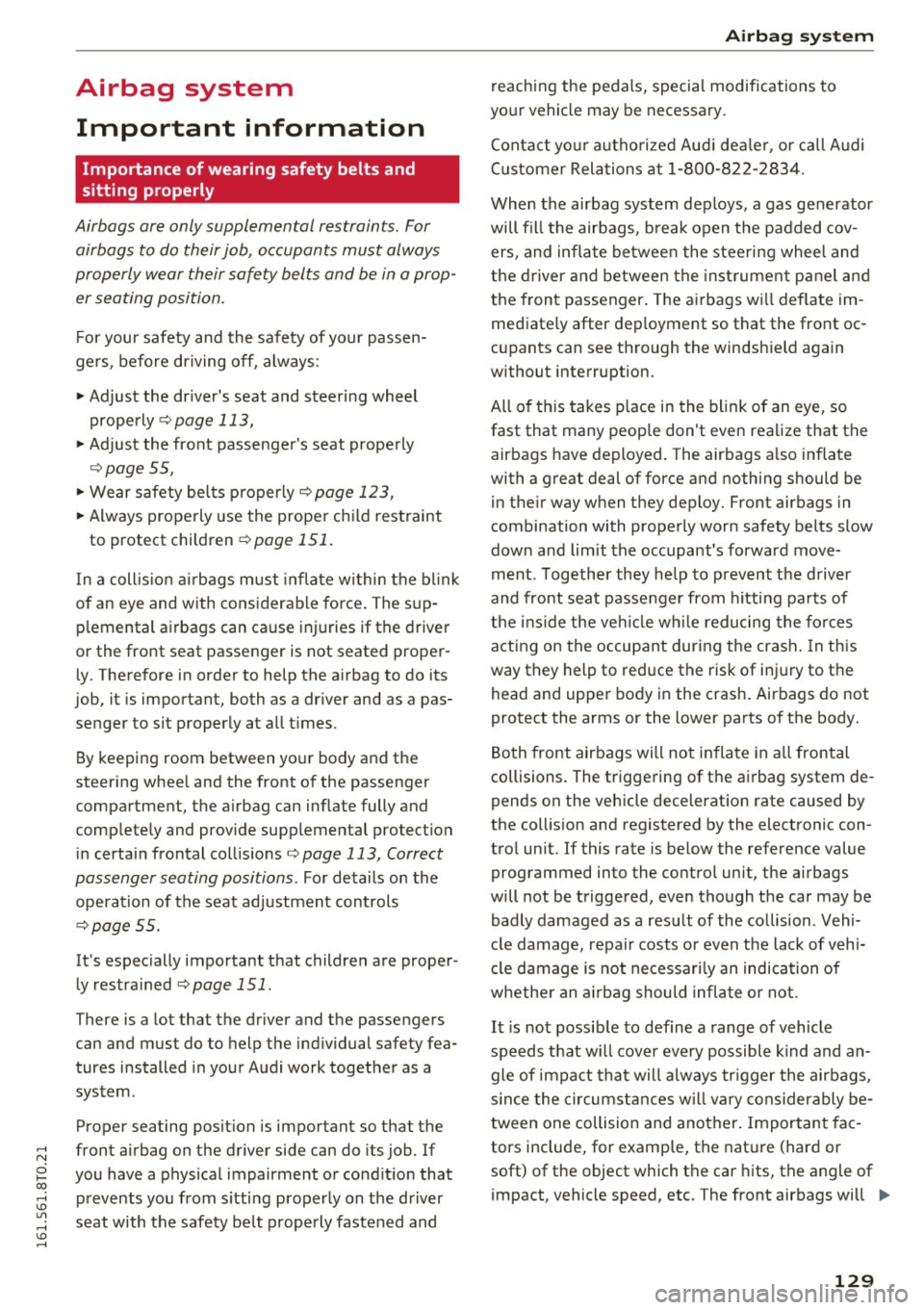
.... N
0 I-co ....
Important information
Importance of wearing safety belts and
sitting properly
Airbags are only supplemental restraints. For
airbags to do their job, occupants must always
properly wear their safety belts and be in a prop er seating position.
For your safety and the safety of your passen
gers, before driving off, always :
""Adjust the driver's seat and steering wheel
properly 9page
113,
""Adjust the front passenger's seat properly
9page 55,
.,. Wear safety belts properly 9 page 123,
.,. Always properly use the proper child restraint
to protect children
9 page 151.
In a collision airbags must inflate within the blink
of an eye and with considerable force. The sup
plemental airbags can cause injuries if the driver
or the front seat passenger is not seated proper
ly . Therefore in order to help the airbag to do its
job, it is important, both as a driver and as a pas
senger to sit properly at all times .
By keeping room between your body and the
steering wheel and the front of the passenger
compartment, the airbag can inflate fully and
completely and provide supplemental pro tection
in certain frontal collisions
o page 113, Correct
passenger seating positions .
For details on the
operation of the seat adjustment controls
o page 55.
It 's especially important that children are proper
ly restrained
9page 151.
There is a lot that the driver and the passengers
can and must do to help the individual safety fea
tures installed in your Audi work together as a
system.
Proper seating position is important so that the
front airbag on the driver side can do its job. If
you have a physical impairment or condition that prevents you from sitting properly on the driver
seat with the safety belt properly fastened and
Airbag system
reaching the pedals, special modifications to
your vehicle may be n ecessary.
Contact your authorized Audi dealer, or call Audi
Customer Relations at 1-800-822-2834.
When the airbag system deploys, a gas generator
will fill the airbags , break open the padded cov
ers, and inflate between the steering wheel and
the driver and between the instrument panel and
the front passenger. The airbags will deflate im
mediately after deployment so that the front oc
cupants can see through the windshield again
without interruption.
All of this takes place in the blink of an eye, so
fast that many people don't even realize that the airbags have deployed. The airbags also inflate
with a great deal of force and nothing should be in their way when they deploy. Front airbags in
combination with properly worn safety belts slow
down and limit the occupant's forward move
ment . Together they help to prevent the driver
and front seat passenger from hitting parts of
the inside the vehicle while reducing the forces
acting on the occupant during the crash. In this
way they help to reduce the risk of injury to the head and upper body in the crash. Airbags do not
protect the arms or the lower parts of the body.
Both front airbags will not inflate in all frontal
collisions. The triggering of the airbag system de
pends on the vehicle deceleration rate caused by
the collision and registered by the electronic con
trol unit . If this rate is below the reference value
programmed into the control unit, the airbags
will not be triggered, even though the car may be
badly damaged as a result of the collision . Vehi
cle damage, repair costs or even the lack of vehi
cle damage is not necessarily an indication of
whether an airbag should inflate or not.
It is not possible to define a range of vehicle
speeds that will cover every possible kind and an
gle of impact that will always trigger the airbags ,
since the circumstances will vary considerably be
tween one collision and another. Important fac
tors include, for example, the nature (hard or soft) of the object which the car hits, the angle of
impact, vehicle speed, etc . The front airbags will
IIJJ,
129
Page 132 of 264
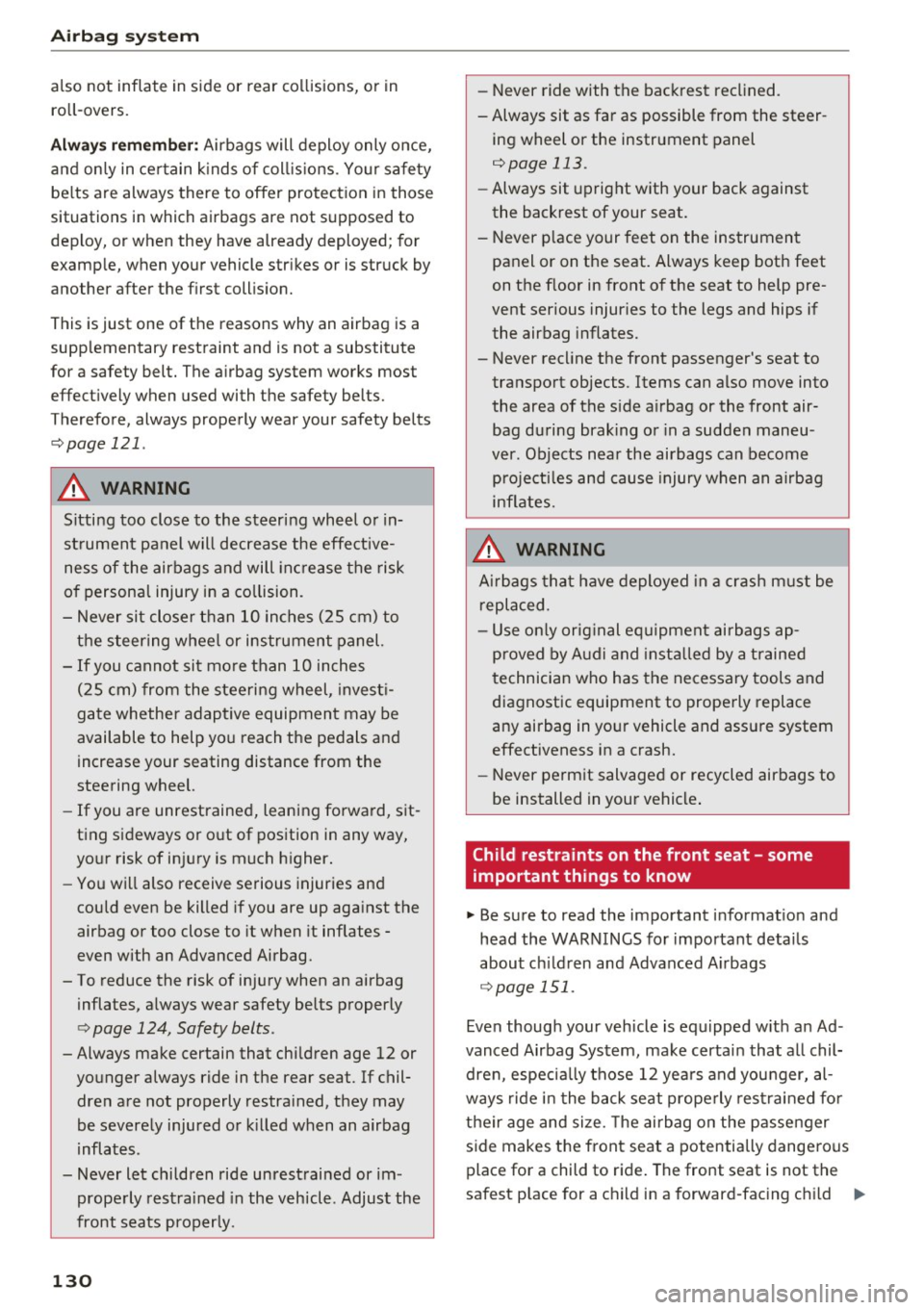
Airbag syste m
also not infl ate in s ide or rear collisions, o r in
ro ll-overs.
Al wa ys rememb er: Airbag s will depl oy on ly once ,
a nd on ly in ce rtain k inds of coll is ions. Yo ur safety
be lts are always there to offer protection in those
situations in which airbags are not supposed to
dep loy, or when they have already deployed; for
examp le, when your vehicle str ikes or is struck by
another after the first collis ion.
This is just one of the reasons why an airbag is a
supp lementary restraint and is not a substitute
for a safety belt. The a irbag system works most
effect ively when used with the safety belts.
There fore, always properly wear your safety belts
r=;, page 121.
A WARNING
Sitting too close to the steering wheel or in
st rument panel will decrease the effective
ness of the airbags and will inc rease the risk
of personal injury in a co llision.
- Never sit closer than 10 inches (25 cm) to
the steering wheel or instrument panel.
- If you cannot sit mo re than 10 inches
(25 cm) from the steering wheel, invest i
gate whether adaptive equipment may be
available to help yo u reach the pedals and
increase your seating distance from the
steering wheel.
- If you are unrestrained, leaning forwa rd, s it
ting sideways or o ut of pos ition in any way,
your risk of in jury is much h igher.
- Yo u will also receive serious injuries and
could even be killed if you are up aga inst the
airbag or too close to it when it inflates -
even with an Advanced Airbag.
- To reduce the risk of injury when an airbag inflates, a lways wear safety belts properly
c> page 124, Safety belts.
-Always make certain that chi ldren age 12 or
younger always ride in the rear seat. If chil dren are not properly restra ined, they may
be severe ly injured or k illed when an airbag
inflates.
- Never let children ride unrestrained or im prope rly restrained in the vehicle . Adjust the
front seats properly.
130
-
- Never ride with the back rest recl ined.
-Always sit as far as possible from the steer -
ing wheel or the instrument panel
c>page 113.
-Always sit upright with your back against
the backrest of your seat.
- Never p lace your feet on the ins trument
panel or on the seat. Always keep both feet
on the floor in front of the seat to help pre
vent serious injur ies to the legs and hips if
the airbag inflates.
- Never recl ine the front passenger's seat to
transpo rt objects. Items can also move into
the area of the s ide a irbag or the front air
bag du ring brak ing or in a sudden maneu
ver. Objects near the airbags can become
proje cti les and cause injury when an airbag
inflates.
A WARNING
A irbags that have deployed in a crash m ust be
replaced.
- Use on ly orig inal equipment airbags ap
proved by A udi and inst alled by a trained
technician who has the ne cessary tools and
diagnostic equipment to prope rly replace
any airbag in yo ur vehicle and assure system
effectiveness in a crash.
'
- Never permit salvaged or recycled airbags to
be installed in your vehicle .
Child restraints on the front seat - some
important things to know
.,. Be sure to read the important i nformat ion and
head the WARNINGS fo r important details
about c hildren and Advanced A irbags
r=;, page 151 .
Even thoug h your veh icle is equipped w it h an Ad
vanced Airbag Sys tem, make certa in that a ll chil
dre n, espec ia lly those 12 yea rs and younger, al
ways ride i n the b ack seat prope rly res trained fo r
their age and size. The airbag on the passenger
s ide makes the front seat a potentially dange rous
p lace for a child to r ide . The front seat is not the
safest place for a chi ld i n a forward-fac ing chi ld ...,.
Page 133 of 264
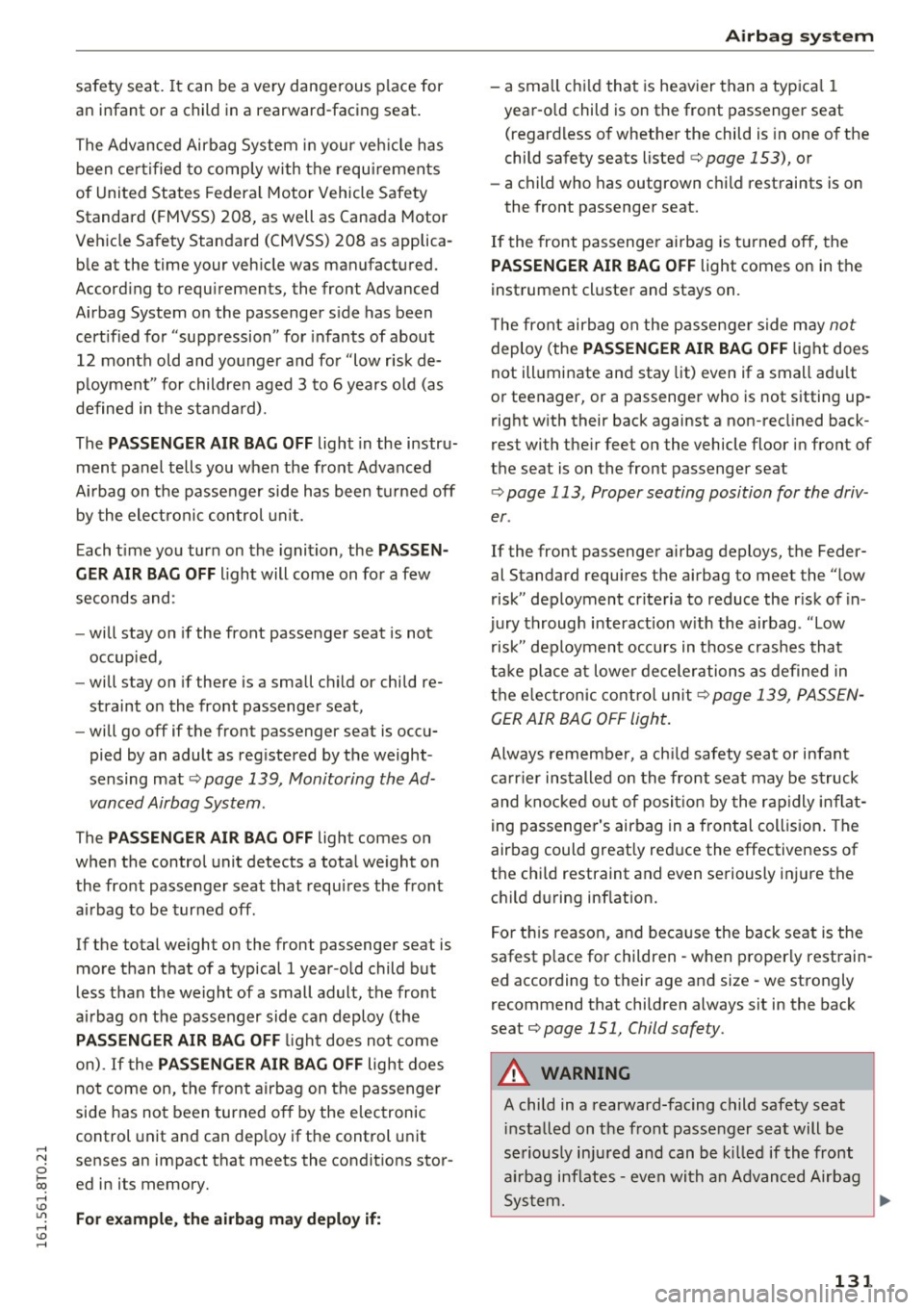
.... N
0 I-co ....
an infant or a child in a rearward -facing seat .
The Advanced Airbag System i n your ve hicle has
been ce rtified to comply with the requi rements
of United States Federal Motor Vehicle Safety
Standard (FMVSS) 208, as well as Canada Motor
Veh icle Safety Standard (CMVSS) 208 as applica
b le at the time your veh icle was manufactured.
Accord ing to requ irements, the front Advanced
Airbag System o n the passenger s ide has been
cert ified for "suppression" for infants of about
12 month old and younger and fo r "low risk de
p loyment " for children aged 3 to 6 years o ld (as
defined in the standard).
The
PASSENGER AIR BAG OFF light in the instru
ment panel tells you when the front Advanced
A irbag on the passe nger side has been t urned off
by the ele ctronic con trol unit.
E ach t ime you tur n on the ignit ion, the
PASSEN
GER AIR BAG OFF
l ight will come on fo r a few
seconds and:
- wi ll stay on if the front passenger seat is not
occup ied,
- will stay on if there is a small c hild or child re
straint on the front passenger seat,
- will go off if the front passenger seat is occu
pied by an adult as reg istered by the weight
sensing mat¢
page 139, Monitoring the Ad
vanced Airbag System .
The PASSENGER AIR BAG OFF light comes on
when the control unit detects a total we ight on
the fro nt passenge r seat that requires the front
a ir bag to be tur ned off.
If the total weight on the front passenger seat is more than that of a typical 1 year -old child but
l ess t han the weight of a small adult, the front
a ir bag on the passenger side can deploy (the
PASSENGER AIR BAG OFF light does not come
on).
If t he PASSENGER AIR BAG OFF light does
not come on, the front airb ag on the passenge r
side has not been turned o ff by the e lectronic
control unit and can dep loy if the control unit
senses an impact that meets the condit ions stor
ed in its memory.
For example , the ai rbag may deploy if:
Airb ag sys tem
-a small ch ild that is heav ier than a typ ica l 1
year-o ld child is on the front passenger seat
(regardless of whether the child is in one of the
child safety seats listed
¢ page 153), or
- a child who has outgrown c hild restraints is on
the front passenger seat.
If t he front passenge r airbag is t urned off, the
PASSENGER AIR BAG OFF light comes on in the
inst rument cluste r and stays on.
T he front airbag on the p assenger s ide may
not
deploy (the PASSENGER AIR BAG OFF light does
not ill uminate and stay lit) even if a small adu lt
o r teenager, or a passenger who is not sitting up
rig ht w ith their back against a non-recl ined back
rest with the ir feet on the vehicle floor in front of
t h e seat is on the fron t passenger seat
¢ page 113, Proper seating position for the driv
er .
If the front passenger a irbag deploys, the Feder
al Standard requ ires the a irbag to meet the " low
risk" deployment criteria to reduce the r isk of in
jury through interaction w ith the airbag . "Low
risk" deployment occurs in th ose crashes that
t ak e place at lowe r decele rations as defined in
t h e e lectron ic co ntr ol unit¢
page 139, PASSEN
G ER A IR BAG O FF light.
Always re m embe r, a ch ild safety sea t or infant
ca rr ie r ins talled on the fro nt seat may be s truck
and knocked ou t of posit io n by the rapidly i nflat
ing passenge r's airbag in a fron tal coll is ion . The
airbag could great ly red uce the effectiveness of
t h e child restraint and even seriously in ju re the
child du ring inflation.
F or t his reason, an d beca use the back seat is the
safest p lace for children -when p roper ly restrain
ed according to their age and size -we strongly
recommend that children always sit in the back
seat ¢
page 151, Child safety .
A WARNING
-A child in a rearward-facing child safety seat
i nsta lled on the front passenger seat will be
se riously in jured and can be k illed if the front
a ir bag inflates -even with an A dva nced Airbag
S ys tem.
~
131
Page 134 of 264
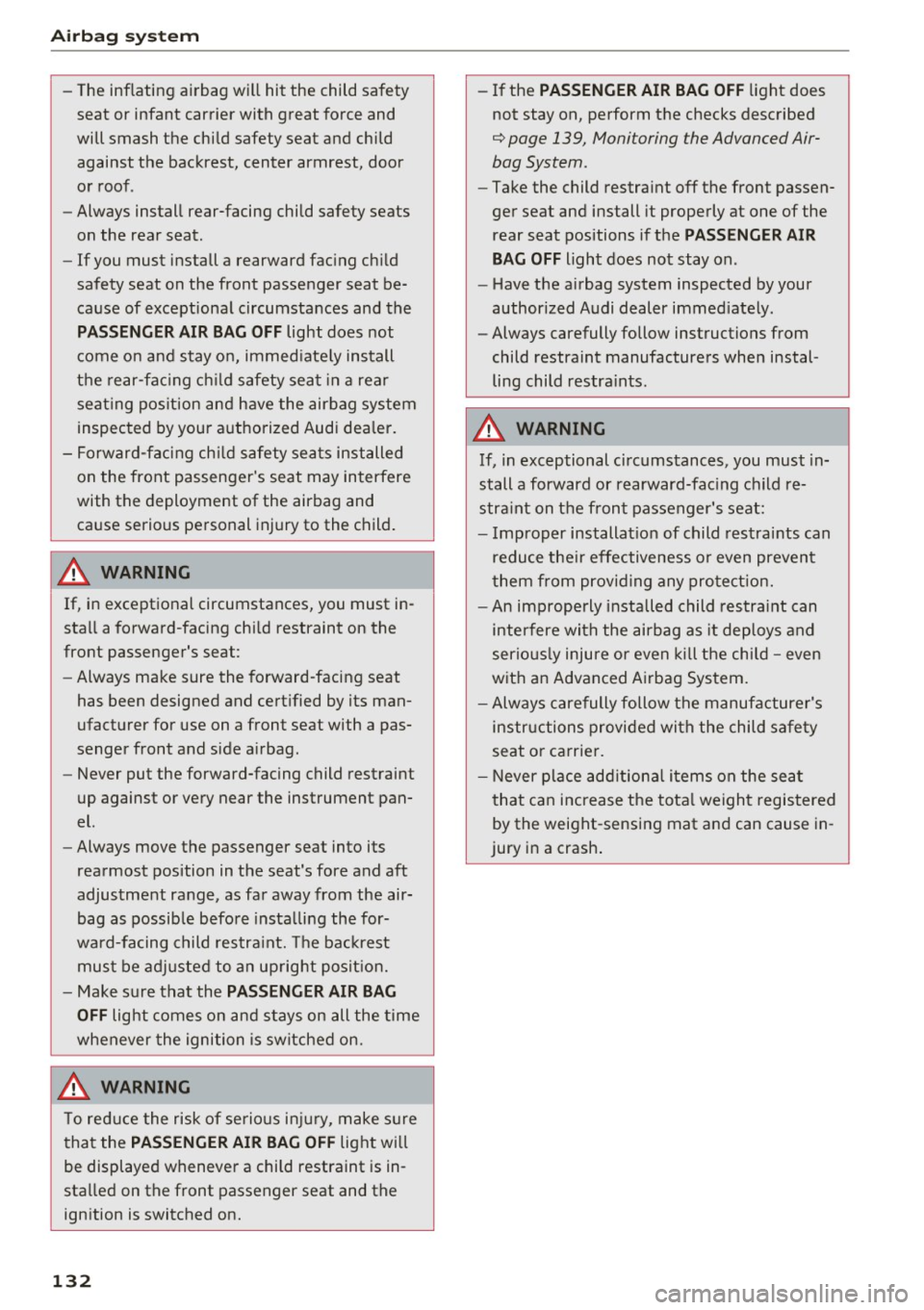
Airbag syste m
-The inflating airbag will hit the child safety
seat or infant carrier with great force and
will smash the child safety seat and child
against the backrest, center armrest, door
or roof .
- Always install rear-facing child safety seats
on the rear seat .
- If you must install a rearward facing child
safety seat on the front passenger seat be cause of exceptional circumstances and the
P ASS ENGER AIR BAG OFF light does not
come on and stay on, immed iate ly install
the rear-fac ing ch ild safety seat in a rear
seat ing pos ition and have the airbag system
inspected by your authorized Audi dea ler.
- Forward-facing ch ild safety seats installed
on the front passenger's seat may interfere
with the deployment of the airbag and
cause serious personal injury to the child .
A WARNING
If, in exceptional circumstances, you must in
stall a forward-facing chi ld restraint on the
front passenger's seat:
- Always make sure the forward-facing seat
has been designed and certified by its man
ufacturer for use on a front seat with a pas
senger front and side a irbag .
- Never put the forward-facing child restraint
up against or very near the instrument pan
el.
-Always move the passenger seat into its
rearmost position in the seat 's fore and aft
adjustment range, as fa r away from the air
bag as possib le before insta lling the for
ward-facing child restra int. The bac krest
mus t be adjusted to an up right posit ion.
- Make s ure that the
PASSENGER AI R BAG
OFF
light comes on and s tays on all the time
whenever the ignition is switched on.
A WARNING
To red uce the risk of serio us in jury, make s ure
that the
PASSENGER AIR BAG OFF light wi ll
be displayed whenever a child restraint is in
stalled on the front passenger seat and the
ign ition is switched on.
132
- If the PASSENGER AIR BAG OF F light does
not stay on, perform the checks described
¢ page 139, Monitoring the Advanced Air
bag System .
-Take the child restra int off the front passen
ger seat and install it properly at one of the
rear seat positions if the
PA SSENGER AIR
BAG OFF
light does not stay on .
- Have the airbag system inspected by your
author ized Audi dealer immed iately .
- Always carefully follow instructions from
child restraint manufacturers when instal
ling child restra ints.
A WARNING
If, in exceptional circumstances, you must in
stall a forward or rearward-fac ing child re
stra int on the fron t passenger's seat:
- Improper installat ion of child restraints can
reduce the ir effectiveness or even prevent
them from provid ing any pro tect ion.
- An improperly installed child res tra int can
inter fere with the airbag as it deploys and
serious ly injure or even kil l the child -eve n
w ith an Advanced A irbag System.
- Always carefully follow the manufacturer's
instructions provided with the child safe ty
seat o r carrier.
- Never p lace add ition al items on the seat
that can increase the tota l weight registered
by the weight -sensing mat and can cause in
jury in a crash .
Page 135 of 264
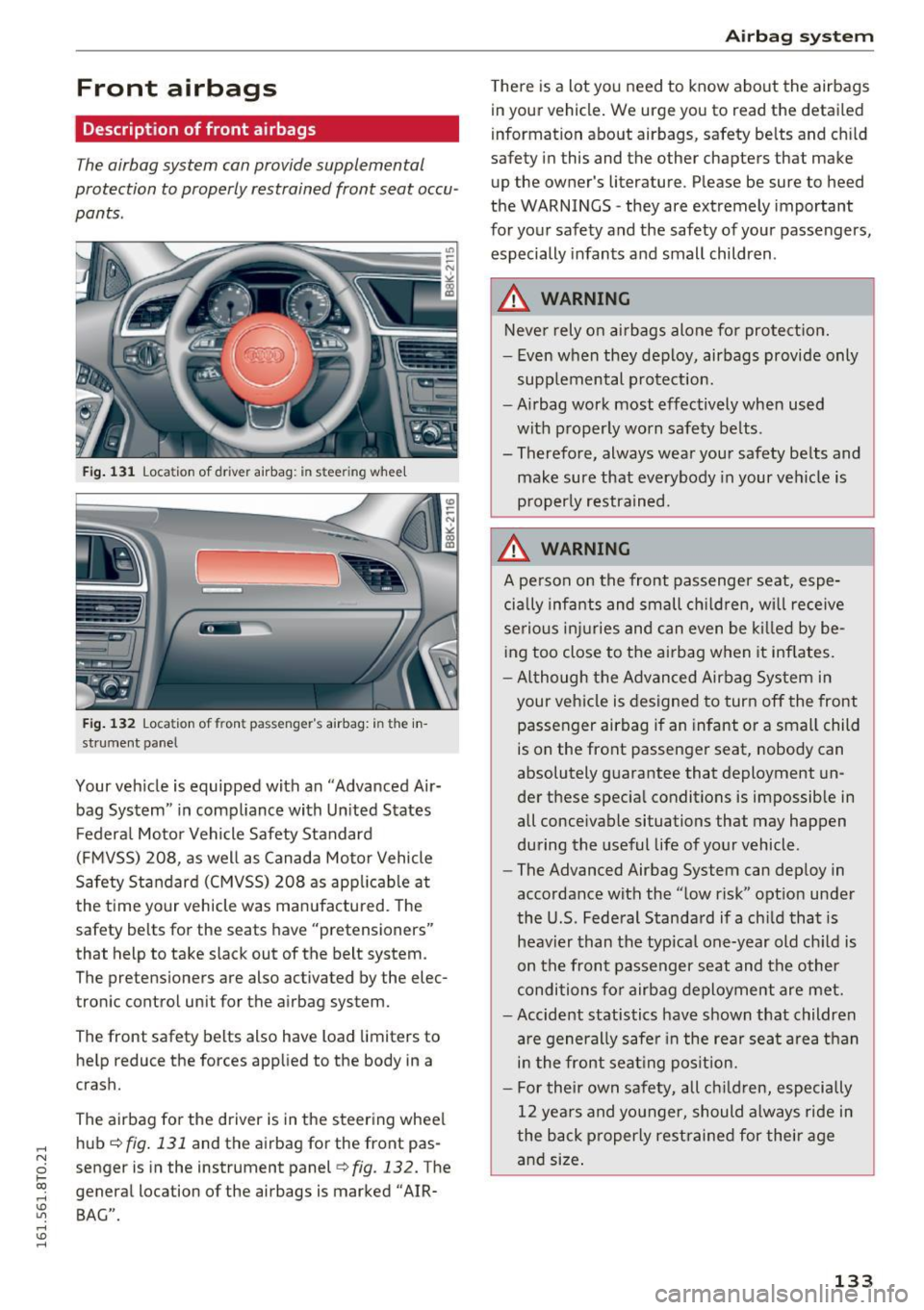
,-1 N
0 1-CX)
,-1 I.Cl U"I
,-1 I.Cl ......
Front airbags
Description of front airbags
The airbag system can provide supplemental
protection to properly restrained front seat occu
pants .
Fig. 131 Loca tion of driver airbag: in steering wheel
Fig. 132 Loca tion of fron t passenger's airbag: i n the in
st rument panel
Your veh icle is equipped with an "Advanced Air
bag System" in compliance with United States
Federa l Motor Vehicle Safety Standard
(FMVSS) 208, as well as Canada Motor Vehicle
Safety Standard (CMVSS) 208 as app licab le at
the time your vehicle was manufactured . The
safety belts for the seats have "pretensioners"
that help to take slack out of the belt system.
The pretensioners are also activated by the elec
tronic control unit for the airbag system.
The front safety belts also have load limiters to help reduce the forces applied to the body in a
crash.
The airbag fo r the driver is in the steering whee l
hub ¢
fig. 131 and the airbag for the front pas
senger is in the instrument panel¢
fig. 132. The
general location of the airbags is marked "AIR
BAG".
Airb ag sys tem
There is a lot you need to know about the airbags
in your vehicle . We urge you to read the detai led
information about airbags, safety belts and ch ild
safety in this and the other chapters that make
up the owner's literature. Please be sure to heed
the WARNINGS -they are extremely important
for your safety and the safety of your passengers, especially infants and small children .
_&. WARNING
Never rely on a irbags alone fo r protect ion.
- Even when they deploy, airbags provide only supplemental protection.
-Airbag work most effectively when used with proper ly worn safety be lts .
- Therefore, always wear your safety belts and make sure that everybody in your vehicle is
properly restrained.
_&. WARNING
--A pe rson on the front passenger seat, espe
cially infants and small ch ild ren, w ill receive
se rious inj ur ies and can even be k illed by be
i ng too close to the airbag when it inf lates.
- Although the Advanced Airbag System in
your vehicle is designed to turn off the front passenger airbag if an infant or a small child
is on the front passenger seat, nobody can
absolutely guarantee that deployment un
der these special conditions is impossib le in
all conceivable situations that may happen
during the useful life of your vehicle .
- The Advanced Airbag System can dep loy in
accordance with the "low risk" opt ion under
the U.S. Federal Standard if a ch ild that is
heavier than the typ ical one-year old ch ild is
on the front passenger seat and the other
conditions for airbag deployment are met.
- Accident statistics have shown that children
are generally safer in the rear sea t area than
in the front sea ting pos ition.
- For their own safety, all c hildren, especially
12 yea rs and younger, should always ride in
the back properly restrained for their age and size .
133
Page 136 of 264
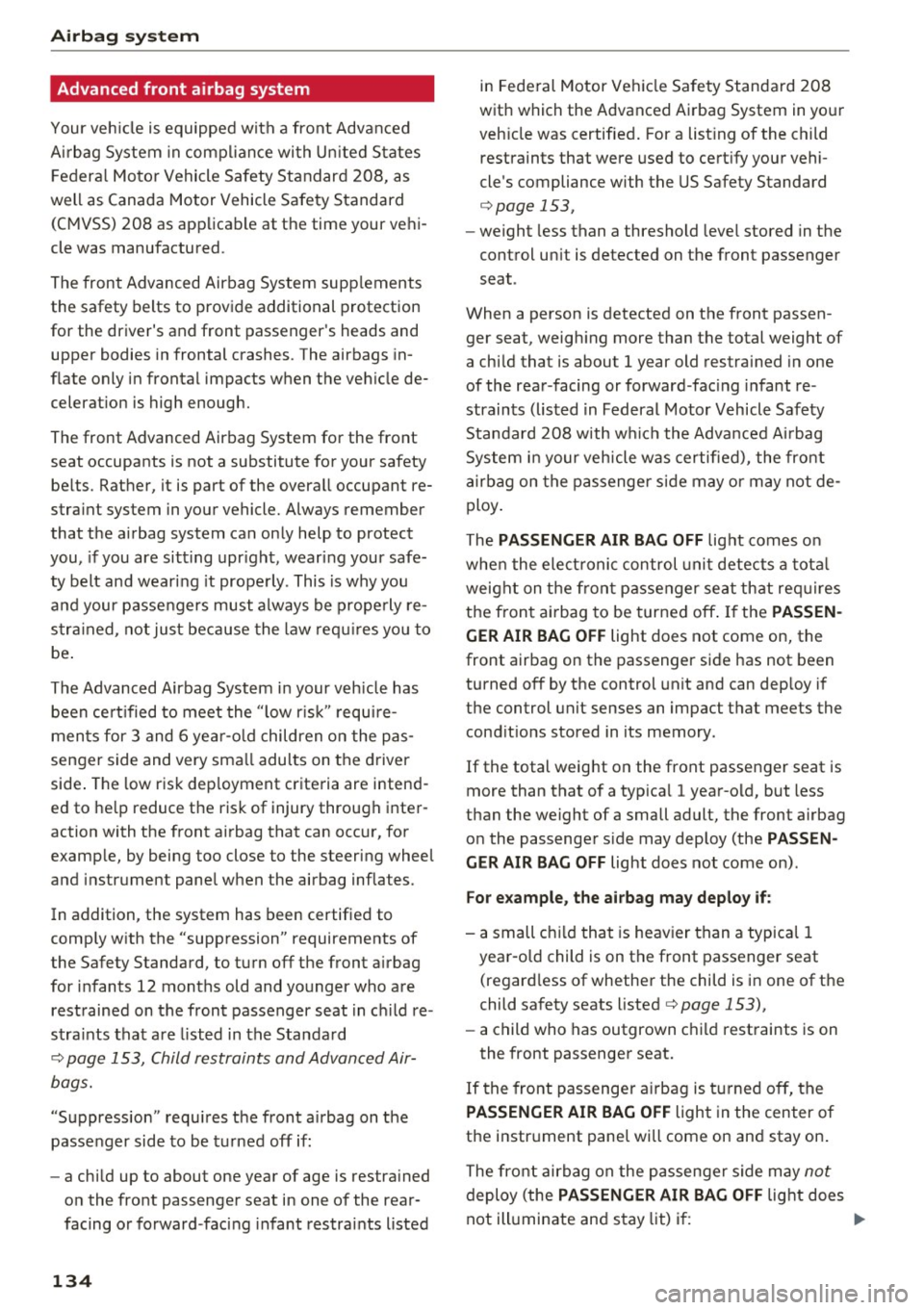
Airbag syste m
Advanced front airbag system
Your vehicle is equippe d with a fr ont Adva nce d
A irbag System in compl iance with Un ited States
F edera l Motor Vehicle Safety Standard 208, as
well as Canada Motor Vehicle Safety Standard
(CMVSS) 208 as applicable at th e tim e your vehi
cle was manufactured .
The front Advanced Airbag System supp lements
the safety belts to provide additional protection
for the driv er's and front passenger's heads and
upper bodies in frontal crashes . The airbags in
flate only in front al impacts when the veh icle de
celerat ion is high enough.
The front Advanced Airbag System for the front
seat occupants is not a substitute for your safety be lts . Rather, it is part of the overall occupant re
stra int system in your vehicle. Always remember
that the airbag system can on ly help to protect
you, if you are sitt ing upr ight, wear ing your safe
ty belt and wear ing it prope rly . This is why you
and your passengers must always be prope rly re
s trai ned, not just because the law req uires yo u to
be .
The Advanced Airbag System in your veh icle has
been ce rtified to meet the " low r isk" requ ire
men ts for 3 and 6 yea r-old children on the pas
senger side and very sma ll adults on the driver
side . T he low risk dep loyment criteria are intend
ed to he lp reduce the risk of injury through i nter
action with the front a irbag that can occur, for
examp le, by being too close to the steering wheel
and ins trument pane l when the airbag inflates.
In addition, the system has been certified to
comply w ith the "suppression" requirements of
the Safety Standard, to turn
off the front a irbag
for i nfants 12 months old and younger who are
restrained on the front passenger seat in c hild re
stra ints that are listed in the Standa rd
¢ page 153, Child restraints and Advanced Air
bags.
"Suppression" requ ires the front a irbag on the
passenger side to be t urned
off if:
- a chi ld up to about one year of age is restra ined
on the fro nt passenger seat in one of the rear
facing or forward -facing infant restraints listed
134
in Federal Motor Veh icle Safety Standard 208
with which the Advanced Airbag System in your
veh icle was certified . For a list ing of the child
restraints that were used to cert ify your vehi
cle's compliance with the US Safety Standard
¢ page 153,
-weight less than a threshold leve l stored in the
control un it is detected on the front passenger
seat .
When a person is detected on the front passen ger seat , weighing more than the total weight of
a chi ld that is about 1 year old restrained in one
of the rear -facing or forward -fac ing infant re
straints (listed in Federal Motor Vehicle Safety
Standard 208 w ith w hich the Adva nced Ai rbag
System i n your veh icle was certified), the front
a irbag on the passenge r side may or may not de
ploy .
The
PASSENGER AIR BAG OFF lig ht comes o n
whe n the elect roni c control unit detects a tota l
weight on the front passe nger seat th at req uires
the front airbag to be turned
off . If the PASSEN
GER AIR BAG OFF
light does not come on, the
front airbag on the passenger side has not been
turned
off by the control unit and can dep loy i f
the control unit senses an impact that meets the
cond it ions stored in its memory .
If the total weight on the front passenger seat is
more than that of a typ ica l 1 year-old, but less
than the weight of a small adult, the front airbag
o n the passenger s ide may deploy (the
PASSEN
GER AIR BAG OFF
light does not come on) .
For example , the ai rb ag ma y deploy if :
- a small ch ild that is heav ier than a typica l 1
year-old child is on the front passenger seat (regard less of whether the child is in one of the
child safety seats listed¢
page 153),
-a child who has outgrown c hil d rest raints is on
the front passenger seat.
If the front passenger a irbag is t urned
off, the
PASSENGER AIR BAG OFF light in the center of
the instr ument panel will come on and stay on .
The fro nt airbag on the passenge r side may
not
deploy (the PASSENGER AIR BAG OFF light does
not illuminate and stay lit) if : ..,.
Page 137 of 264
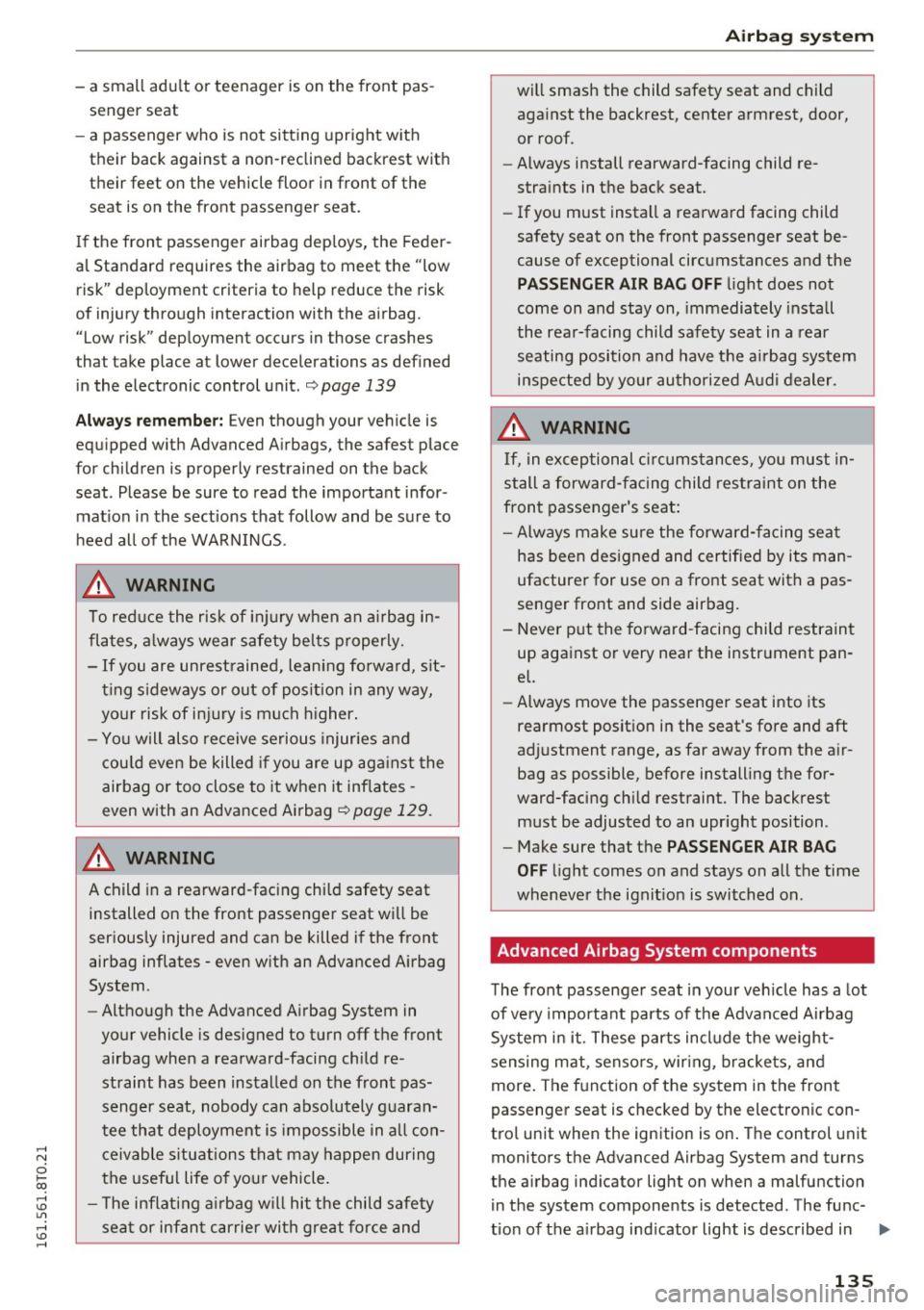
.... N
0 Ico ....
s e nger seat
- a passenger who is not sitting uprigh t w ith
their back against a non-reclined backrest with
their feet on the vehicle floor in front of the
seat is on the front passenger seat.
I f the front passenger airbag dep loys , the Feder
al Standard requires the airbag to meet the "low
risk" deployment criteria to help reduce the risk
of injury through interaction with the airbag.
"Low risk" dep loyment occurs in those crashes
t ha t take place at lower decelera tions as defined
in the electronic control unit.¢
page 139
Alway s rem ember: Even though your vehicle is
equipped w ith Advanced Airbags, the safest place
f or children is properly restrained on the back
seat . Please be sure to read the important infor
mat ion in the sections that follow and be sure to
heed all of the WARN INGS.
.&, WARNING
To reduce the r isk of inj ury when an a irbag in
flates, a lways wear safety belts p roperly.
- If you are unrest rained, leaning fo rwa rd, s it
t ing s ideways or o ut of pos ition in any way,
yo ur risk of in jury is much h igher .
- Yo u will also receive serious injur ies and
cou ld even be killed if you are up aga inst the
airbag or too close to it when it inflates -
even with an Advanced Airbag¢
page 129.
.&_ WARNING
A child in a rearward-facing chi ld safety seat
installed on the front passenge r seat w ill be
ser iously injured and can be killed if the front
airbag inflates -even with an Advanced A irbag
System .
- Although the Advanced A irbag System in
your vehicle is designed to turn off the front
airbag when a rearward-facing child re
straint has been installed on the front pas senger seat, nobody can absolu tely g uaran
tee that deployment is impossible in a ll con
c eivable s ituations that may happen during
the useful life of your vehicle .
- The inflating a irbag w ill hit the child safety
seat or infant carrier wi th great force and
Airb ag sys tem
will smash the child safety seat and child
aga inst the backrest, center armrest, door,
or roof.
- Always install rearward-facing child re
stra ints in the back seat.
- If you must install a rearward facing child
safety seat on the front passenger seat be
cause of exceptional circumstances and the
PAS SENGER AIR BAG OFF light does not
come on and stay on, immediately install
the rea r-facing child safety seat in a rear
seating position and have the a irbag system
inspected by your au thorized Audi dealer.
.&_ WARNING
If, in exceptional c ircumstances , you must in
stall a forward-facing child res traint on the
front passenger's seat:
- Always make sure the forward-fa cing seat
has bee n des igned and certified by its man
ufacturer for use on a front seat with a pas
senger front and side airbag.
- Never p ut the fo rward-facing child restraint
up against or very near the instr ument pan ·
el.
-Always move the passenger seat into its
rearmost position in the seat's fore and aft
ad justment range, as far away from the a ir
bag as possible, before install ing the for
ward-facing ch ild restraint. The backrest
m ust be adjusted to an upr ight position .
- Make sure that the
PASSENGER AIR B AG
OFF
li ght comes on and stays on all the time
whenever the ignit ion is switched on .
Advanced Airbag System components
The front passenger seat in your veh icle has a lot
of ve ry important parts of the Advanced Airbag
System i n it. These parts incl ude the weight
sensing mat, senso rs, wir ing , b racke ts, and
more . The f unction o f the system in the front
passenger seat is checked by the electronic con
tro l unit when the ign ition is on . The control unit
monitors the Advanced Airbag System and turns
the a irbag ind icator light on when a malfunction
in the system components i s detected. The func-
tion of the a irbag ind icator light is described in .,.
135
Page 138 of 264

Airbag syste m
greater detail below. Because the front passen
ger seat contains important parts of the Ad
vanced Airbag System, you must take care to pre
vent it from being damaged. Damage to the seat m ay prevent the Advanced Airbag for the front
passenger seat from doing its job in a crash .
The front Advanced Airba g Sy stem con sists
of the follo wing :
-Crash sensors in the front of the vehicle that
measure vehicle acceleration/deceleration to
provide information to the Advanced Airbag
System about the seve rity of the crash .
- An electronic control un it, with integrated
crash sensors for front and side impacts . The
contro l unit "decides " whethe r to fire the front
airbags based on the information received from
the crash sensors. The control unit a lso "de
cides" whether the safety be lt pretensioners
shou ld be activated.
- An Advanced Airbag with gas generator and
contro l valve for the driver ins ide the steering
whee l hub .
- An Advanced Airbag with gas generator and
contro l valve inside the instrument pane l for
the front passenger .
- A weight -sensing mat under the upho lstery
padding of the front passenger seat cushion
that measures th e total weight on the seat . T he
information registered is sent continuously to
the e lec tronic control unit to regu la te dep loy
ment of the front Advanced A irbag on the pas
senger side .
- An airbag monitoring system and indica tor
l ight in the instrument cluster
r=> page 139.
-A sensor in each front sea t registers the dis
tance between the respective seat and the
steering wheel or instrument panel. The infor mation reg istered is sent continuous ly to the
electronic control u nit to regulate deployment
of the front Advanced A irbags.
- T he
PASSEN GE R AIR B AG OFF light comes on
and stays on in the center of the inst rument
pane l
c> page 139, fig . 134 and tells you when
the front Advan ced Airbag on the passenger
side has been turned off .
- A sensor below the safety belt la tch fo r the
front seat passenger to meas ure the tension on
136
the safety belt. The tension on the safety belt
and the weight reg istered by the weight-sens
ing mat help the contro l unit "decide" whether
the front airbag for the front passenger seat
should be turned
off or not c> page 130, Child
restraints on the front seat -some important
things to know .
-A sensor in the safety belt latch for the driver
and for the front seat passenger that senses
whether that safety belt is latched or not and
transmits this information to the e lectronic
cont rol u nit.
_&. WARNING
Damage to the front passenge r seat can pre
vent the front airbag from work ing properly .
- Improper repair or disassembly of the front
passenger and driver seat will prevent the
Advanced Airbag System from f unctioning
proper ly.
- Repairs to the front passenger seat mus t be
performed by qualified and proper ly trained
wo rkshop personne l.
- Never remove the front passenger or driver
seat from the vehicle.
- Never remove the upholstery from the front
passenger seat.
- Never d isassemble or remove pa rts from the
seat o r disconnect wi res from it.
- Never carry sharp objects in your pocke ts or
place them on the seat. If the weight-sens
ing mat in the passenger seat is p unctured
it cannot work proper ly.
- Never carry things on your lap or carry ob jects on the passenger seat. Such items can increase the weight reg istered by the
weight-sensing mat and send the wrong in
formation to the airbag control unit.
- Never store items under the front passenger
seat . Parts of the Advanced Airbag System
under the passenger seat could be dam
aged, preventing them and the airbag sys
tem from working properly .
- Never p lace seat covers or replacement up
holstery that have not been specifically ap
proved by Audi on the front seats.
- Seat covers can prevent the Advanced A ir
bag System from recognizing child
Page 139 of 264

,-1 N
0 1-CX)
,-1 I.Cl U"I
,-1 I.Cl ......
restraints or occupants on the front passen
ger seat and prevent the side airbag in the
seat backrest from deploying properly.
- Never use cushions, pillows, blankets or
similar items on the front passenger seat.
The additional padding will prevent the
weight-sensing mat in the seat from accu
rately registering the child restraint or per
son on the seat and prevent the Advanced
Airbag System from functioning properly .
- If you must use a child restraint on the front passenger seat and the child restraint man
ufacturer's instructions require the use of a
towel, foam cushion or something else to
properly position the child restraint, make
certain that the
PASSENGER AIR BAG OFF
light comes on and stays on whenever the
child restraint is installed on the front pas
senger seat.
- If the
PASSENGER AIR BAG OFF light does
not come on and stay on, immediately in
stall child restraint in a rear seating position
and have the airbag system inspected by
your authorized Audi dealer .
How the Advanced Airbag System
components work together
The front Advanced Airbag System and the side
airbags supplement the protection offered by the
front three-point safety belts with pretensioners
and load limiters and the adjustable head re
straints to help reduce the risk of inju ry in a wide
range of accident and crash situations. Be sure to
read the important information about safety and
heed the WARNINGS in this chapter.
Deployment of the Advanced Airbag System and
the act ivation of the safety be lt pretensioners de
pend on the deceleration measured by the crash
sensors and regis tered by the electronic control
unit . Crash severity depends on speed and decel
eration as well as the mass and stiffness of the
vehicle or object involved in the crash .
On the passenger side, regardless of safety belt
use, the airbag will be turned off if the weight on
the passenger seat is less than the amount pro grammed in the elect ronic control unit. The front
Airbag system
airbag on the passenger side will also be turned
off if one of the child safety seats that has been
certified under Federal Motor Vehicle Safety
Standard 208 has been recognized on the seat.
The
PASSENGER AIR BAG OFF light comes on
and stays on to tell you when the front Advanced
Airbag on the passenger side has been turned off
q page 130, Child restraints on the front seat -
some important things to know .
_&. WARNING
To reduce the risk of injury when an airbag in
flates, always wear safety belts properly.
- If you are unrestrained, leaning forward, sit
ting sideways or out of position in any way,
your risk of injury is much higher.
- You will also receive serious injuries and
could even be killed if you are up against the
airbag or too close to it when it inflates -
even with an Advanced Airbag
qpage 129.
More important things to know about front
airbags
Fig. 133 Inflated front airbags
-.... N 0 :i:
~
Safety belts are important to help keep front
seat occupants in the proper seated position so
that airbags can unfold properly and provide sup
plemental protection in a frontal collision .
The front airbags are designed to provide addi
tional protection for the chest and face of the
driver and the front seat passenger when:
- safety belts are worn properly,
- the seats have been positioned so that the oc-
cupant is properly seated as far as possible
from the airbag, ..,.
137
Page 140 of 264
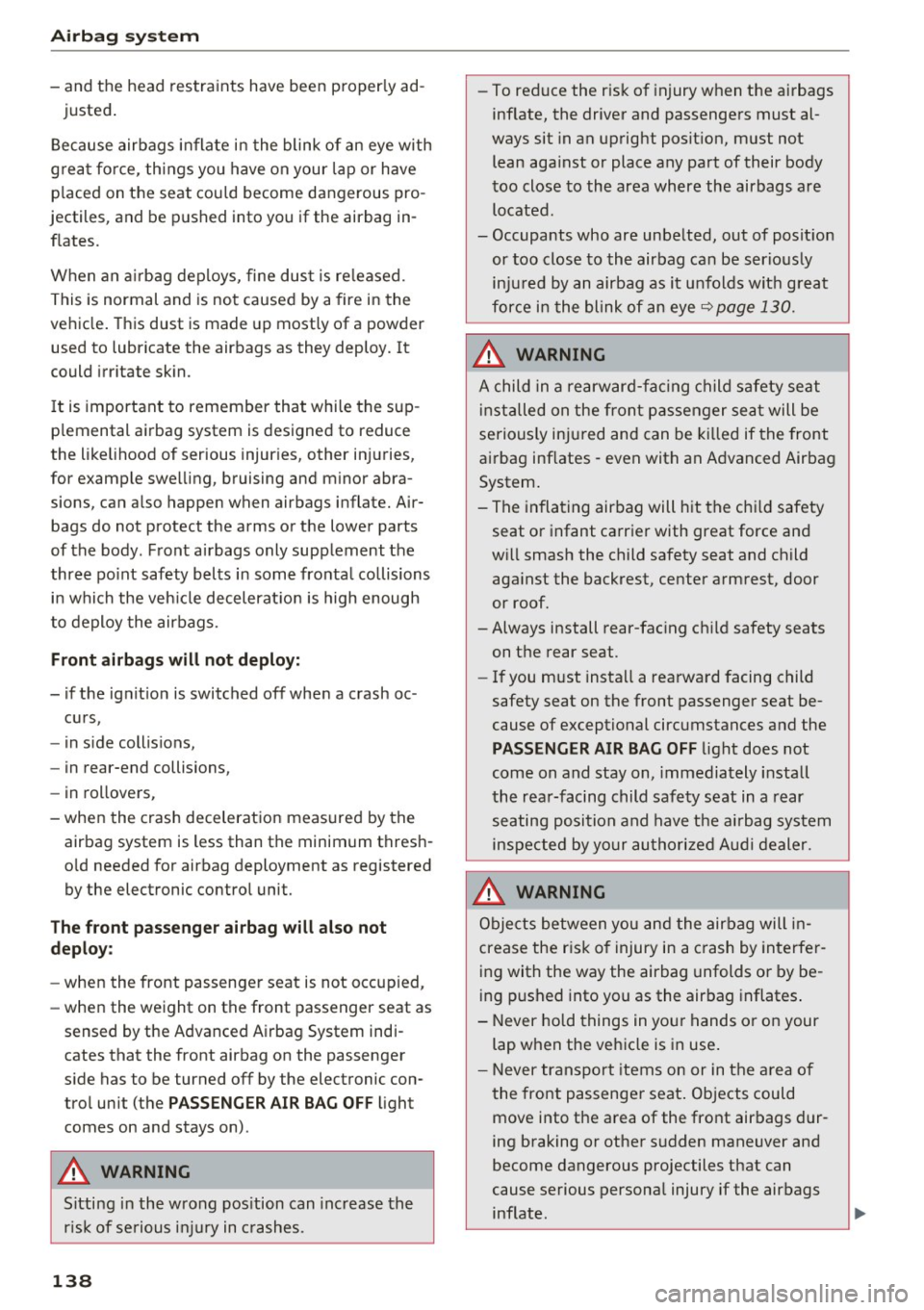
Airbag syste m
-and the head restraints have been properly ad -
justed .
Because airbags i nflate i n the blink of an eye w ith
g reat for ce, th ings you have on your lap or have
p laced on the seat cou ld become dangerous pro
jectiles, and be pushed into you if the airbag in
flates .
When an a irbag deploys, fine dus t is re leased.
This is normal and is not caused by a fire in the
vehicle . This dust is made up mostly of a powder
used to lubricate the airbags as they deploy. It
could irr itate sk in.
It is important to remember that whi le the sup
p lemental airbag system is designed to reduce
the likelihood of serious injur ies, other in juries,
for example swelling, bruising and m inor abra
sions, can also happen when airbags inflate. Air bags do not protect the arms or the lower parts
of the body . Front airbags only supplement the
three po int safety belts in some fronta l co llisions
i n which the veh icle decelerat ion is high enough
to deploy the airbags.
Fr ont airbags w ill not deploy:
- if the ignit ion is switched off when a crash oc -
curs ,
- in s ide collisions,
- in rear-end collisions,
- in rollovers,
- when the crash decelerat ion measured by the
airbag system is less than the minimum thresh
o ld needed for airbag deployment as registered
by the electronic control unit.
The front pass eng er airbag will also not
depl oy :
- when the front passenger seat is not occupied,
- when the weight on the front passenger seat as
sensed by the Advanced A irbag System indi
cates that the front airbag on the passenger
s ide has to be turned off by the electronic con
trol unit (the
PAS SENGER AIR B AG OFF light
comes on and stays on) .
A WARNING
Sitting in the wrong pos ition can increase the
r is k of se rious i njury in c rashes.
138
- To reduce the risk o f injury when the airbags
inflate, the driver and passengers must al
ways sit in an upright position, must not
lean aga inst or place any part of their body
too close to the area where the airbags are
located.
- Occupants who are unbelted, out of posit ion
or too close to the airbag can be serious ly
in ju red by an airbag as it unfolds wit h great
force in the blink of an eye
c:> page 130.
A WARNING
A child in a rearward-fa cing child safety seat
installed on the front p assenger sea t will be
seriously injured and can be killed if the front
airbag inflates -even with an Advanced Airbag
System.
- The inflating airbag will hit the chi ld safety
seat o r infant ca rrier with great force and
w ill smash the child safety seat and child
aga inst the backrest, center a rmrest, door
or roof.
- Always install rear-fac ing ch ild safety seats
on the rear seat.
- If you must insta ll a rearwa rd facing child
safety seat on the front passenger seat be
cause of exceptional circumstances and the
PAS SENGER AIR BAG OFF light does not
come on and stay on, immediately install
the rea r-facing child safety seat in a rear
seating position and have the ai rbag system
inspected by your au thori zed Au di d ealer.
A WARNING
Objects between you and the airbag will i n
crease the r is k of injury in a crash by interfer
ing with the way the airbag unfolds or by be
ing p ushed into you as the airbag inflates .
- Never hold things in yo ur hands o r on your
lap when the vehicle is in use .
- Never transport items on or in the area of
the front passenger seat . Objects could
move into the area of the front airbags dur
ing braking or other sudden maneuver and
become dangerous projectiles that can
cause serious persona l injury if the airbags
inflate.